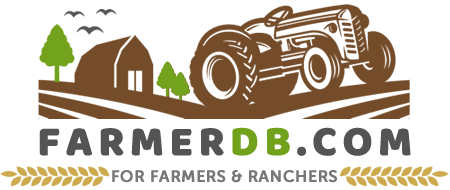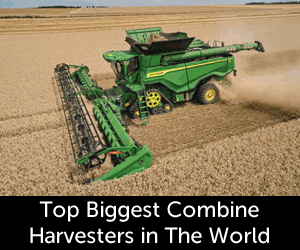Suffolk sheep are a domestic breed primarily raised for meat production, although they also produce moderate amounts of wool.
This breed originated in England, developed in the late 18th century by crossing Southdown rams with Norfolk Horn ewes. The goal was to create a sheep that combined the Southdown’s meat quality with the Norfolk Horn’s hardiness and size.
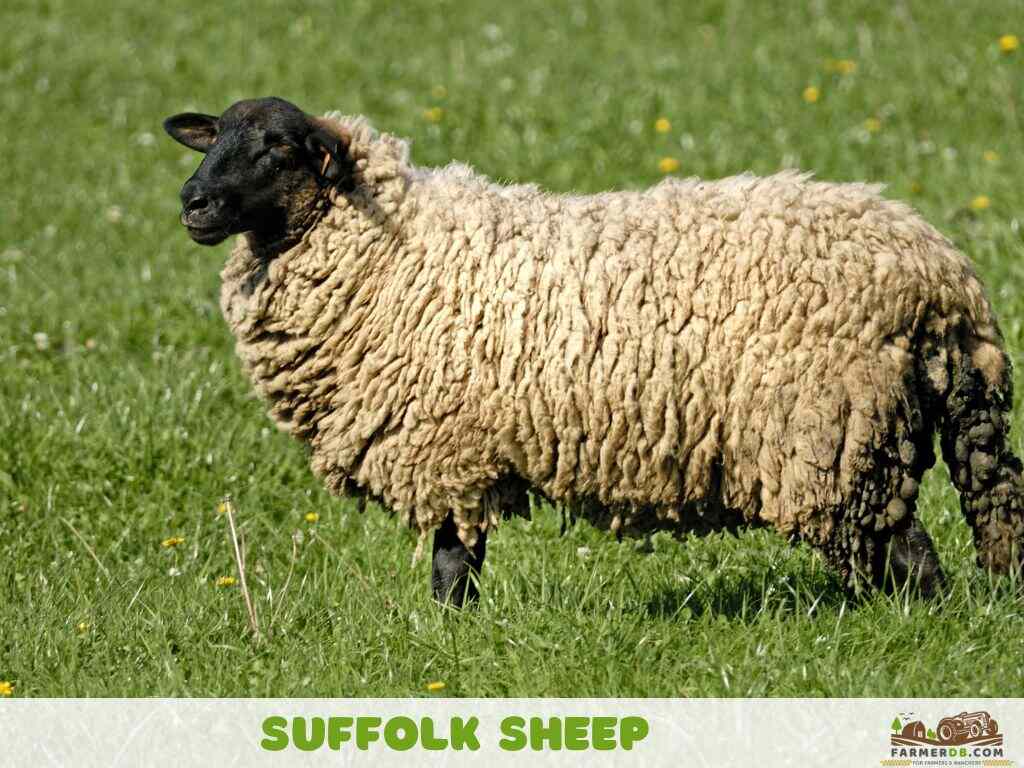
Today, Suffolk sheep are widely raised around the world, including in the United Kingdom, United States, Australia, and New Zealand.
Contents
Characteristics
Color
The color of this sheep breed is white with a distinct pattern of a black head, ears, and legs.
Skin
The skin is fine, soft, and pink.
Head
The head is moderately sized, smooth, and covered with fine, thick hair. The muzzle is long, smooth, and slightly arched, with a strong jaw where the incisors align perfectly with the pad.
The ears are long, bell-shaped, and gently angle downward toward the corners of the mouth. The eyes are bright, full, and well-positioned.
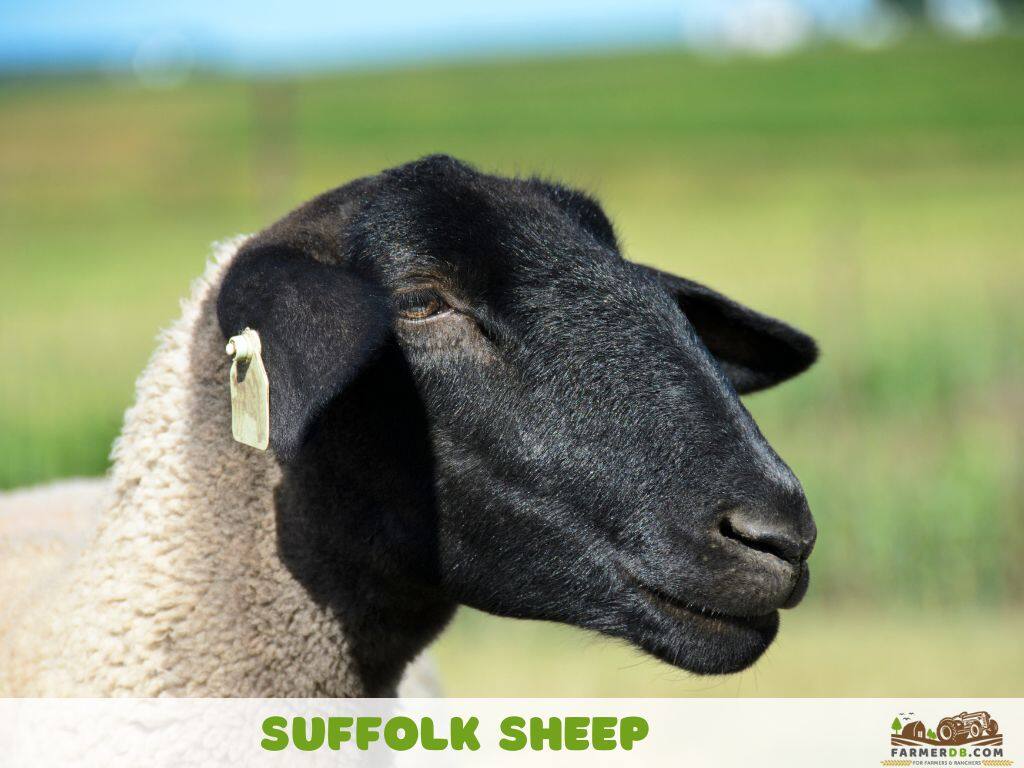
Horns
Suffolk sheep are a polled breed.
Neck, Shoulders
The neck is moderately long and well-positioned. In rams, it is stronger and has a prominent crest. The shoulders are broad and sloping, blending smoothly into the neck and barrel.
Chest, Lower Rib
The chest is deep and wide, giving the sheep a robust appearance. This depth carries into the lower ribs, which are long and well-sprung.
Back, Loin
The back features a straight spine that runs from the base of the neck to the tailhead. It is long, level, and covered with well-developed muscle.
The ribs are wide and well-arched at the top, extending deeply downward, while the loin is broad, long, and thick.
Rump and Twist
The rump is level and wide, extending from the hooks to the pins. The sheep’s width across the hooks should be approximately one-third of its height at the withers.
The tailhead is broad, level, and well-positioned, with the width extending down to the stifles. A full, deep twist enhances this area, making it the most productive section for meat.
Belly
The belly is covered with wool, which adds to the overall protection of the sheep in colder weather.
Legs, Feet
The legs and feet are straight and composed of flat, strong bones. They are covered with wool up to the knees and hocks but remain clean below. The front legs are well-spaced, while the hind legs are muscular and well-filled with meat.
Fleece
The fleece is moderately short, with fine, close fibers that do not mat or felt together and remain well-defined without blending into dark wool or hair.
Reproductive traits
Yearling rams have a scrotal circumference of at least 35 centimeters. Their testicles are smooth, even, and symmetrical, with well-defined epididymis. The scrotum is fully closed at the bottom.
Milking ewes have well-developed udders, resembling half a large cantaloupe, with teats of medium size that are positioned correctly. The vulva on ewes is well-shaped and points downward.
Size
This sheep breed is known for its large size.
The average body length of this breed is 50 inches (127 cm). In terms of height, Suffolk males stand at an average of 31.5 inches (80 cm), while females are slightly smaller, with an average height of 29 inches (74 cm).
Lifespan
These sheep can live for 11 to 13 years.
This lifespan is considered a long one in the sheep world, mostly because most breeds have an average lifespan of 10 to 12 years, making Suffolk’s potential longevity slightly above average when properly cared for.
Growth Rate
How fast do they grow?
This sheep breed has a fast growth rate, with an average daily weight gain for a male lamb of 0.5 to 0.6 lbs (0.227 to 0.276 kg).(see refs.)
According to the data, the average daily gain is higher in single lambs compared to those born as twins or triplets. Triplets have the lowest average daily gain, particularly during the first 100 days of life.
| Litter Size | Average Daily Gain (lbs/day | kg/day) |
|---|---|
| Singles | 0.518 (0.235) |
| Twins | 0.499 (0.226) |
| Triplets | 0.497 (0.226) |
Some farmers who have raised this breed argue that the actual weight gain is not fast but rather more moderate.
Weight
Mature rams can have a weight ranging from 250 to 350 lbs (113 to 159 kg). The ewes weigh less but still maintain a solid weight of 180 to 250 lbs (81 to 113 kg).
The average birth weight of a lamb (single-lamb pregnancy) is approximately 11 to 11.5 lbs (5.0 to 5.2 kg) from a first-time mother and about 12 to 12.5 lbs (5.4 to 5.6 kg) from a mature ewe.
In the case of a multiple-lamb pregnancy, the average birth weight of each lamb is generally lower compared to a single-lamb pregnancy.
| Number of Lambs | Shearlings (lbs/kg) | Mature Ewes (lbs/kg) |
|---|---|---|
| Singles | 11.5 (5.2) | 12.3 (5.6) |
| Twins | 9.3 (4.2) | 10.4 (4.7) |
| Triplets | 8.2 (3.7) | 8.8 (4.0) |
At 8 weeks (56 days), the weight ranges from 55.1 to 91.1 lbs (25 to 41.3 kg), while at 21 weeks (147 days), it increases to 103.6 to 194.2 lbs (47 to 88.1 kg).
| Days | Weight Range (lbs | kg) |
|---|---|
| 56 (8 weeks) | 55.1 to 91.1 lbs (25 to 41.3 kg) |
| 147 (21 weeks) | 103.6 to 194.2 lbs (47 to 88.1 kg) |
Slaughtered Time
You can slaughter Suffolk sheep at around 6 to 8 months. Some farmers choose to slaughter them earlier, at approximately 4 months, when they can reach a weight of 77–88 lbs (35–40 kg).
The dressing percentage for this breed is 50 to 53%.
Temperament
Suffolk sheep are calm and gentle animals, a trait they get from their Southdown ancestry.
They are easy to handle, especially the ewes, as they are more manageable compared to rams and wethers. These sheep are also quick to learn, which makes them great for hobby farms.
These sheep have strong flock instincts, often following a leader and running together when they sense danger. Being alone causes them stress, so they do best in groups.
They can be herded or moved easily, especially when food is offered as a reward. Suffolk sheep are good grazers and can spend many hours feeding on pasture.
Meat
Suffolk sheep meat has a mild and rich flavor that is not too strong, making it a favorite for many people. The texture is fine and smooth, and the meat is very tender, which makes it easy to cook and enjoy.
These sheep produce meat with a low fat content compared to other breeds.
At 15–16 weeks of age, the backfat thickness is usually around 0.12 inches (3 mm), with a possible range of 0.06 to 0.31 inches (1.5 mm to 8 mm).
The muscle depth at 147 days is between 1.14 to 1.84 inches (29 mm to 46.8 mm), showing a good balance of lean meat and fat for high-quality cuts.
They are popular in the market because they produce meat with great quality. Farmers and butchers prefer them for their high carcass yield and consistent results.
Wool
These sheep produce a dense and fine fleece, classified as down-type wool.
Their fibers are springy, with a micron range of 25–33, making the wool soft and flexible. The fleece is moderately short, measuring 2.1–3.1 inches (5.5–8.0 cm) in length. This length is ideal for spinning, as it is neither too short to come apart nor too long to draft easily.
While it is great for spinning and producing warm, soft yarn, it is not ideal for felting.
The locks are square and dense, and their elasticity makes cleaning easier. Dirt and vegetable matter tend to fall out when the wool is combed or spun, ensuring a smoother process.
In appearance, this wool has a matte finish without the shine found in longwool breeds. It absorbs dyes, whether natural or acid dyes, resulting in rich, deep colors.
Due to their short fleece, these sheep produce a smaller amount of wool, ranging from 5 to 8 pounds (2.25–3.6 kg), with a yield of 50 to 62 percent.
Raising
Feeding
You can feed Suffolk sheep forage such as grass, hay, or silage, which can make up a large portion of their diet.
High-quality pasture is essential, as it provides the nutrients they need to stay healthy. Since Suffolk sheep are natural grazers, forage aligns well with their feeding instincts.
Grains and concentrates can also be added, depending on your farm practices.
Options like barley, oats, and corn provide additional energy, especially for ewes during pregnancy or lactation.
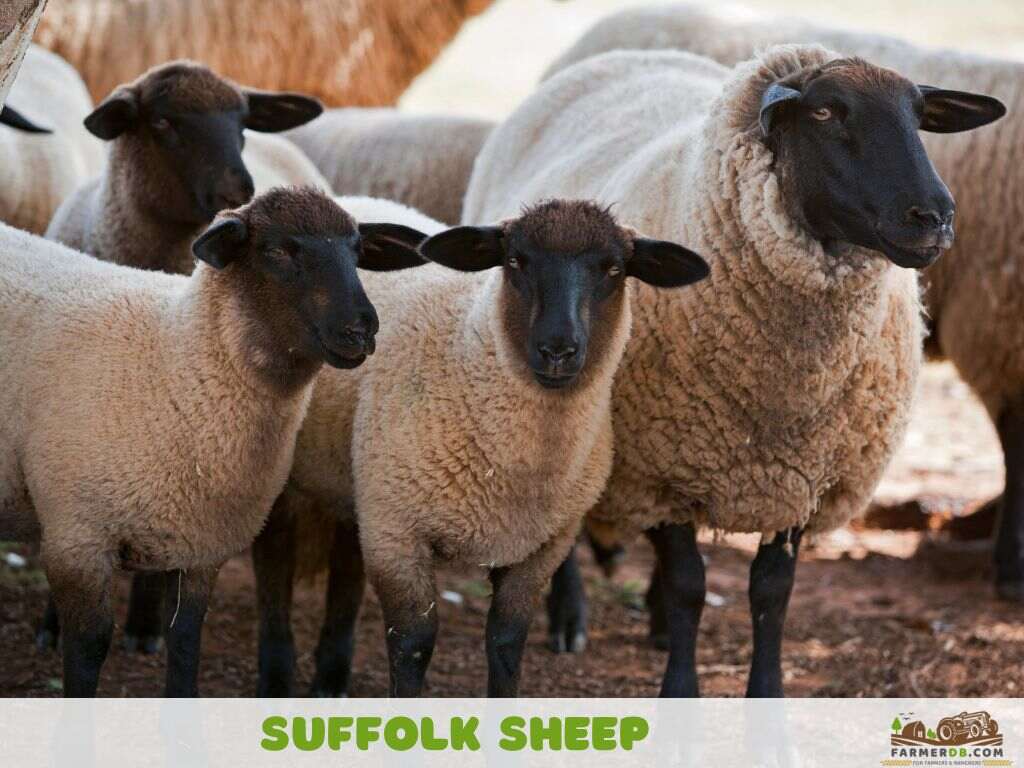
Be cautious when introducing grains, as the digestion of starch in grains is different from the digestion of cellulose in forage. The rumen needs time to adjust. Introducing too much grain too quickly can lower rumen pH and lead to a buildup of lactic acid, potentially causing acidosis or bloat.
Protein supplements such as soybean meal, alfalfa, or lupins are also good options. For growing lambs, the protein level in their diet should range from 16% to a maximum of 18%.
As with any sheep breed, these sheep require access to mineral blocks or supplements, especially those containing calcium, phosphorus, and selenium.
Clean, fresh water should always be available to keep them hydrated and healthy.
Environment
Various farming systems are suitable for raising this sheep breed due to their adaptability.
They perform well in extensive systems, grazing on natural pastures. They are hardy and capable of thriving in open fields or large grazing areas.
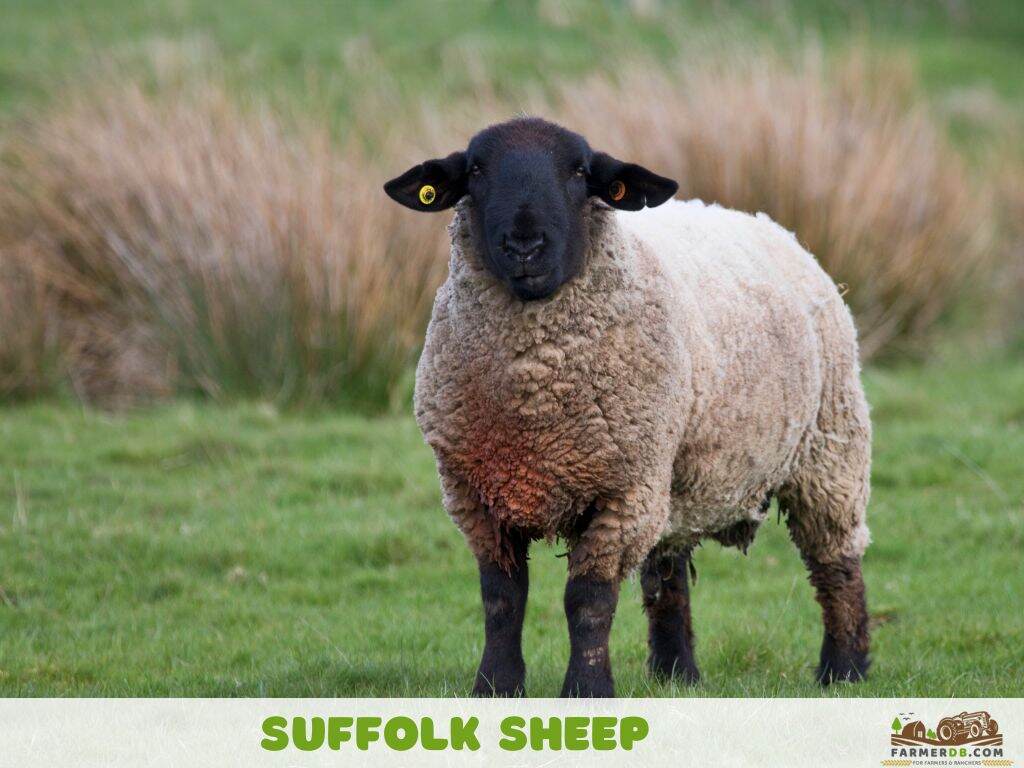
These sheep can also be raised in intensive systems, where they are kept in smaller spaces and provided with a controlled diet of forage, grains, and supplements. Additionally, they can be raised in confinement, where they have no access to pasture and rely entirely on stored feed and supplements.
These sheep are most commonly raised using a semi-intensive system, which combines natural grazing with supplemental feeding to promote optimal growth and productivity.
Climate
They are adaptable and can live in a variety of climates.
They do well in temperate regions with mild temperatures and consistent pastures.
They are strong enough to cope with cold weather, provided they have shelter and enough food. With the right care, they can also live in hot, dry areas if they have access to shade and fresh water.
In humid climates, it is important to take extra precautions to prevent issues like parasites and foot rot. Good drainage and regular maintenance, such as hoof care and parasite prevention, are essential in these environments.
Shelter
Suffolk sheep may not always need shelter in temperate climates, but it can still be very helpful.
Shelter protects them from harsh weather, such as extreme heat, cold, rain, or strong winds, and it also keeps them safe from predators.
Shade is especially important in hot weather to avoid heat stress, while in colder conditions, shelter can help prevent hypothermia in lambs or recently shorn sheep.
During lambing season, a shelter provides a calm and safe place for ewes and their lambs.
While not always required, providing a good shelter is strongly recommended to ensure health and comfort.
How many sheep per acre?
You can raise 3 to 5 sheep per acre if the pasture is of high quality or has abundant grass, provided supplemental feed is given. Without supplemental feed, the stocking rate decreases to 2 to 3 sheep per acre.
According to farmers, Suffolk sheep have a very large appetite.
In areas with poor-quality or limited pasture, the number of sheep per acre should be reduced.
There is no single rule for stocking density, as it is influenced by the climate, regional conditions, how the sheep are managed, and what they are fed.
Breeding
Suffolk sheep are seasonal breeders. Individual ewes have an average breeding season of 187-190 days, with around 10 estrus cycles.
Ewes reach sexual maturity at 6–8 months, but farmers often wait until 10–12 months to breed them.
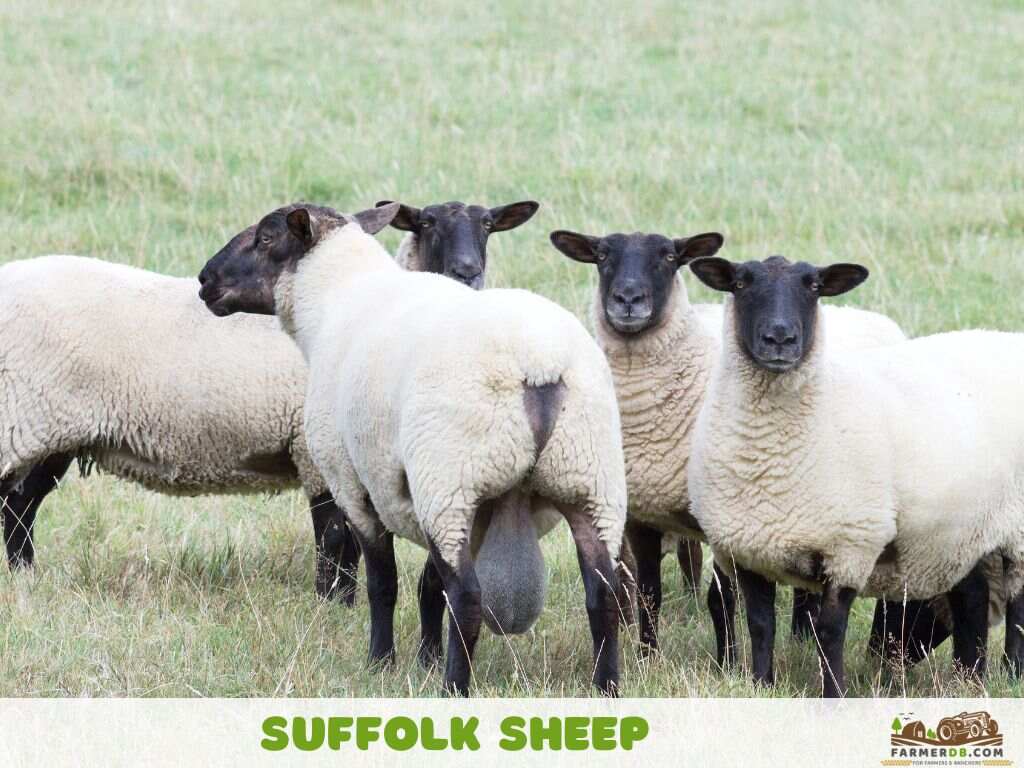
Waiting ensures that young ewes are fully developed, avoiding issues with their growth and reducing the risk of injury from mating with a heavier ram.
Mature rams can serve 100+ ewes, while ram lambs can serve 40+ ewes.
Mature ewes give birth to an average of 1.7 lambs. Lambing is smooth, as the lambs’ wedge-shaped bodies, fine shoulders, and small heads make delivery easier. These lambs are robust and energetic, quickly getting up to nurse after birth.
| Maturity at Lambing | No. of Lambs Born | Range |
|---|---|---|
| Shearling Ewes | 1.58 | 1.3 – 1.8 |
| Mature Ewes | 1.7171 | 1.5 – 1.9 |
Purebred Suffolks demonstrate high prolificacy, with lambing rates exceeding 185%, and crossbreds reaching over 200%.
Both rams and ewes possess valuable traits, which is why they are commonly included in breeding programs to pass on their desirable characteristics.
- Male lines: increase muscular body mass, fast finishing, and prolificacy.
- Female lines: prioritize prolificacy, milk production, early maturing ewe lambs, and maternal qualities.
Health Issues
Suffolk sheep are typically healthy and hardy, but they are more susceptible to scrapie (see refs.) compared to other breeds.
Other health issues that could affect this breed include common sheep diseases, such as foot rot, as well as internal and external parasites.
Preventing these issues requires good management practices, including regular health checks, maintaining clean and dry living conditions, proper nutrition, and parasite control programs.
Why should you raise it?
Advantages
- Fast growth rates
- Good dressing percentage
- Hardy and resilient
- Prolific breeders
- Easy lambing
- Vigorous lambs
- Good maternal traits
- Longevity of rams
Disadvantages
- Size concerns for young ewes
- Nutritional Needs: Their rapid growth and prolificacy require high-quality feed
References
- Evaluation of growth intensity in Suffolk link
- Scrapie link
- New Zealand Suffolk link
- Irish Suffolk Sheep Society link
Do you have any experience with the topic discussed here?
Would you like to improve the information shared and contribute your practical knowledge on the subject?
Your real-world experience as a farmer or rancher could greatly benefit other members, and the community would deeply appreciate your contribution.
